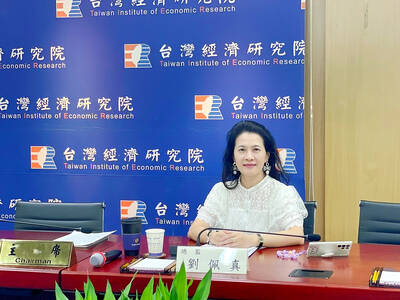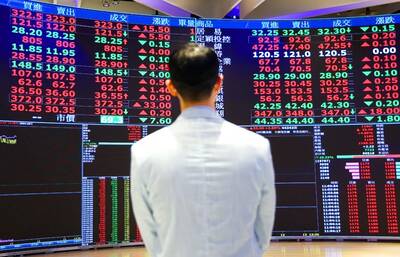Syndicated lending in Asia rebounded last year as companies boosted borrowing to take advantage of the biggest drop in loan interest rates in a decade.
Borrowers led by China National Offshore Oil Corp (中國海洋石油公司) and Origin Energy Ltd pushed lending volumes in the Asia-Pacific region outside Japan to US$423.6 billion last year from US$387.6 billion in 2012, according to data compiled by Bloomberg.
The average interest margins charged for US dollar-denominated loans shrank 23 basis points, the most since at least 2003, to 267 basis points, the data showed.
After sliding 16 percent in 2012, the amount of loans jumped last year ahead of moves by the US Federal Reserve to unwind record stimulus policies that had caused volatility in the bond market and helped lower loan prices.
US dollar bond sales in the region fell almost 50 percent to US$44.9 billion in the second half of last year from US$82.6 billion in the first six months.
“Price tightening in the loan market had a positive impact on overall volumes in 2013,” said Priscilla Lee, the Hong Kong-based head of northeast Asia loan syndications at Bank of Tokyo-Mitsubishi UFJ Ltd. “Spreads are unlikely to drop further this year.”
Interest margins fell in eight of the 11 Asia-Pacific loan markets last year, according to Bloomberg-compiled data.
In Hong Kong, where average margins narrowed by 55 basis points to 230, syndicated facilities surged 81 percent to a record US$63.4 billion, the data showed.
Volumes in Australia climbed 24 percent to US$103.7 billion after loan pricing dropped 62 basis points to 243 basis points.
“There’s still downward pressure on pricing, so we’ll continue to see margin contraction,” said Phil Lipton, Hong Kong-based head of syndicated finance for Asia-Pacific at HSBC Holdings PLC.

IN THE AIR: While most companies said they were committed to North American operations, some added that production and costs would depend on the outcome of a US trade probe Leading local contract electronics makers Wistron Corp (緯創), Quanta Computer Inc (廣達), Inventec Corp (英業達) and Compal Electronics Inc (仁寶) are to maintain their North American expansion plans, despite Washington’s 20 percent tariff on Taiwanese goods. Wistron said it has long maintained a presence in the US, while distributing production across Taiwan, North America, Southeast Asia and Europe. The company is in talks with customers to align capacity with their site preferences, a company official told the Taipei Times by telephone on Friday. The company is still in talks with clients over who would bear the tariff costs, with the outcome pending further

NEGOTIATIONS: Semiconductors play an outsized role in Taiwan’s industrial and economic development and are a major driver of the Taiwan-US trade imbalance With US President Donald Trump threatening to impose tariffs on semiconductors, Taiwan is expected to face a significant challenge, as information and communications technology (ICT) products account for more than 70 percent of its exports to the US, Chung-Hua Institution for Economic Research (CIER, 中華經濟研究院) president Lien Hsien-ming (連賢明) said on Friday. Compared with other countries, semiconductors play a disproportionately large role in Taiwan’s industrial and economic development, Lien said. As the sixth-largest contributor to the US trade deficit, Taiwan recorded a US$73.9 billion trade surplus with the US last year — up from US$47.8 billion in 2023 — driven by strong

A proposed 100 percent tariff on chip imports announced by US President Donald Trump could shift more of Taiwan’s semiconductor production overseas, a Taiwan Institute of Economic Research (TIER) researcher said yesterday. Trump’s tariff policy will accelerate the global semiconductor industry’s pace to establish roots in the US, leading to higher supply chain costs and ultimately raising prices of consumer electronics and creating uncertainty for future market demand, Arisa Liu (劉佩真) at the institute’s Taiwan Industry Economics Database said in a telephone interview. Trump’s move signals his intention to "restore the glory of the US semiconductor industry," Liu noted, saying that

STILL UNCLEAR: Several aspects of the policy still need to be clarified, such as whether the exemptions would expand to related products, PwC Taiwan warned The TAIEX surged yesterday, led by gains in Taiwan Semiconductor Manufacturing Co (TSMC, 台積電), after US President Donald Trump announced a sweeping 100 percent tariff on imported semiconductors — while exempting companies operating or building plants in the US, which includes TSMC. The benchmark index jumped 556.41 points, or 2.37 percent, to close at 24,003.77, breaching the 24,000-point level and hitting its highest close this year, Taiwan Stock Exchange (TWSE) data showed. TSMC rose NT$55, or 4.89 percent, to close at a record NT$1,180, as the company is already investing heavily in a multibillion-dollar plant in Arizona that led investors to assume